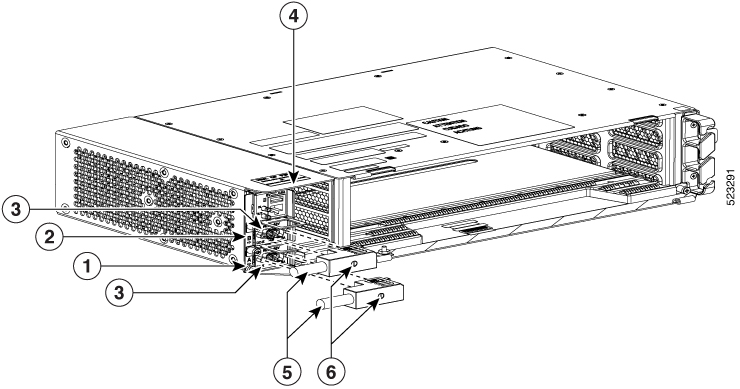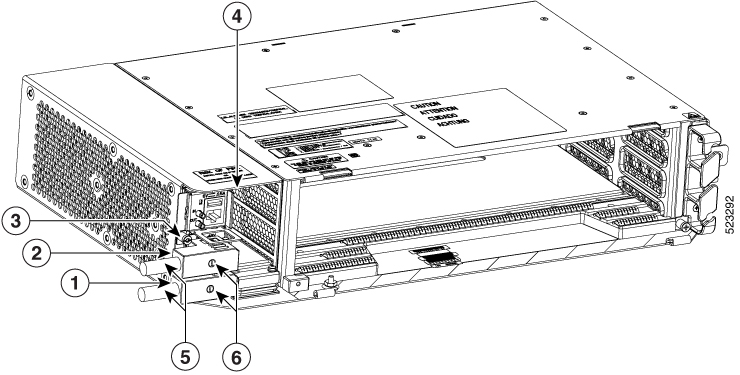Power and Ground Description
Ground the equipment according to Telcordia standards or local practices.
The grounding configuration is mandatory for ANSI and ETSI chassis for both AC and DC configurations.
The following sections describe power and ground for the NCS 2002 shelves.
For detailed instructions on grounding the NCS 2002 chassis, see the Electrostatic Discharge and Grounding Guide for Cisco NCS 2000 Series.
ANSI Power and Ground
For AC power feed, use the power cable shipped with the NCS 2002 and one ground cable. For an AC power supply, the fuse rating must not exceed 10A, 15A, or 20A. For low input voltage ranges, 100V to 127Vac, the branch circuit protection must not be rated more than 20A. The overcurrent/short circuit protection must be in accordance with local and national electrical codes. The voltage rating value for AC power ranges between 100 VAC to 240 VAC depending on the standards in various countries. This product is intended for use on the TN and TT power systems.
The NCS 2002 has redundant –48 VDC #12 single-hole lug power terminals. The terminals are labeled RET(A), RET(B), -48V(A), and -48V(B) on the power module.
To install redundant DC power feeds, use four power cables and one ground cable. For a single power feed, only two power cables (#12 AWG or larger, copper conductor, 194 degrees F [90 degrees C] minimum) and one ground cable (#6 AWG or larger) are required. Use a conductor with low impedance to ensure circuit overcurrent protection. However, the conductor must have the capability to safely conduct any faulty current that might be imposed. For a DC power supply, the fuse rating must not exceed 15A. The voltages –40.5 VDC and –57.6 VDC are, respectively, the minimum and maximum voltages required to power the chassis. The nominal steady state voltage is -48 VDC.
 Note |
Functionality is guaranteed at –40 VDC input voltage, as defined in Telcordia GR-1089-CORE, Issue 5. |
We recommend the following wiring conventions, but customer conventions prevail:
- Red wire for battery connections (–48 VDC).
- Black wire for battery return connections (RET).
- The battery return connection is treated as DC-I, as defined in Telcordia GR-1089-CORE, Issue 6.
The ground lug must be a dual-hole type, UL Listed, CSA certified and rated to accept the #6 AWG cable. Two ground posts with two M5 nuts are provided on the NCS 2002 to accommodate the dual-hole lug.
ETSI Power and Ground
For AC power feed, use the power cable shipped with the NCS 2002 and one ground cable. For an AC power supply, the fuse rating must not exceed 10A, 15A, or 20A. For low input voltage ranges, 100V to 127Vac, the branch circuit protection must not be rated more than 20A. The overcurrent/short circuit protection must be in accordance with local and national electrical codes. The voltage rating value for AC power ranges between 100 VAC to 240 VAC depending on the standards in various countries. This product is intended for use on the TN and TT power systems.
The NCS 2002 for ETSI has redundant –48 VDC power connectors (DSUB for DC power module) on the DC power module. To install redundant power feeds, use the two power cables shipped with the NCS 2002 shelf and one ground cable. For a DC power supply, the fuse rating must not exceed 15A. The voltages –40.5 VDC and –57.6 VDC are, respectively, the minimum and maximum voltages required to power the chassis. The nominal steady state voltage is -48 VDC.
The ground lug must be a dual-hole type, UL Listed, CSA certified and rated to accept the #6 AWG cable. Two ground posts with two M5 nuts are provided on the NCS 2002 to accommodate the dual-hole lug.
 Caution |
Only use the power cables shipped with the NCS 2002 shelf. |











 Feedback
Feedback